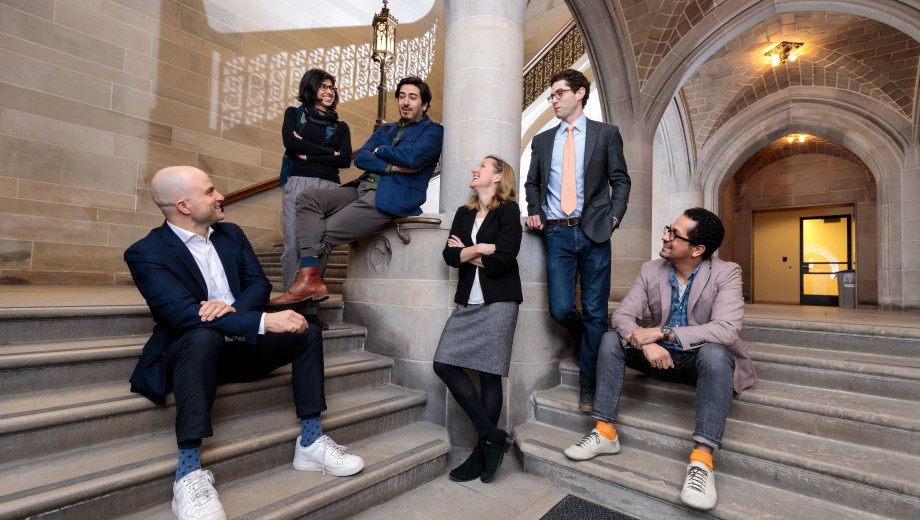In “Team Spirit,” Tableau spoke with six assistant professors in the Department of English Language and Literature about their research. Here, they give us a further glimpse into their work and the department’s distinctively inquisitive and collaborative culture.
When hiring, chair Deborah Nelson explains, she and her colleagues look for scholars “who are really eager to think with other people,” not locked in to a particular vision for how their projects must unfold.
That willingness to engage with new ideas is foundational to how these junior faculty members found their way into the discipline. Benjamin Saltzman discovered the field literally by accident: he went to the wrong classroom as an undergraduate and ended up in a literature class taught by a professor who introduced him to early modern and medieval studies, now his specialty. An encouraging professor nudged Zachary Samalin into his field as well: “I didn’t intend to study the ‘Victorian’ period at all when I started graduate school, but I had an incredible mentor whose work on the history of sexuality led me back into the nineteenth century, and I’ve been happily wandering around in it ever since.” Timothy Harrison calls English “the field in which you could do anything,” and Julie Orlemanski recalls, “I only followed my pleasure.”
Edgar Garcia said that passion alone motivated his decision to study poetry at Chaffey College in California. When he spoke to students at Wilbur Wright, a community college in Chicago, as part of Hispanic Heritage Month, he encouraged them to heed their passion as well, “because it’s one of the most precious things you can have. If you nourish your passion and take care of it, it can sustain you through really dark and difficult things.”
They also say that their students offer fresh perspectives on familiar ideas. “Most of what I learn, I learn from teaching,” Samalin notes. “I’ve been researching disgust for a decade now, but when I teach my course on the literature of disgust, I regularly leave the classroom in possession of a completely new thought that’s come out of classroom discussion.” For example, one of the chapters of his forthcoming book came entirely from a doctoral seminar on urban voyeurism.
Harrison’s book was influenced by his teaching in a signature course—one pitched at a wide audience where English majors don’t necessarily predominate—called Inventing Consciousness. After beginning with his area of expertise, he made the rest of the syllabus “as adventurous as possible,” including works and authors that he wouldn’t normally consider teaching. These included the Upanishads, Aristotle, Augustine, Virginia Woolf, and even Hayy Ibn Yaqzan (Alive, son of Awake), an Arabic philosophical novel from the twelfth century. The experiment paid off: “When I was editing my book, I was taking the things I’d learned from preparing this big undergraduate class and incorporating them.”
The junior faculty find inspiration in their colleagues’ teaching as well. Through The Sonic Image, a course run by W. J. T. Mitchell, the Gaylord Donnelley Distinguished Service Professor in English, Art History, and Visual Arts, Saltzman was introduced to the work of visiting artist Lawrence Abu Hamdan, who stages auditory installations to explore the idea of “ear-witnessing” (a play on “eye-witnessing”) acts of violence. “It’s remarkable because it reorients your expectations about the importance of vision in demonstrating reality or conveying reality,” says Saltzman, connecting Hadman’s work back to his own, which examines the way reactions to violence were depicted in the Middle Ages.
Sonali Thakkar’s experience as a member of working groups for two new College Core sequences—Human Rights in World Civilizations and Gender and Sexuality in World Civilizations—has also proved productive, providing “new opportunities for learning and collaboration. No one person could have written the syllabi for either of those courses on their own; they are really a combination of the expertise and field-specific knowledge of multiple faculty from a range of disciplines.” And in a profession where it can be challenging to find the time to consume recreational media, the predetermined syllabi of Core classes give the faculty the rare chance to engage with works that aren’t directly related to their research projects.
“This year I got really into The Iliad !” Garcia says. Reading it with students “was really fun and interesting, and revealed to me why this book persists.” Likewise, Orlemanski found herself leading a Core class that was enraptured by the famous Walter Benjamin essay “The Work of Art in the Age of Mechanical Reproduction.” Following their passion, “we spent two weeks on it. The degree to which it became something that we were all inside of and thinking with together was really generative.”

